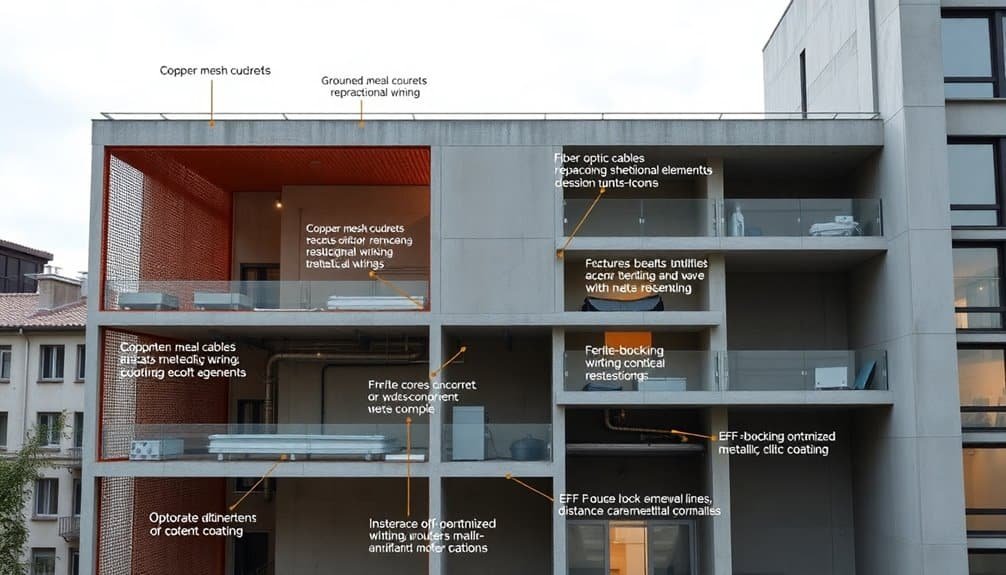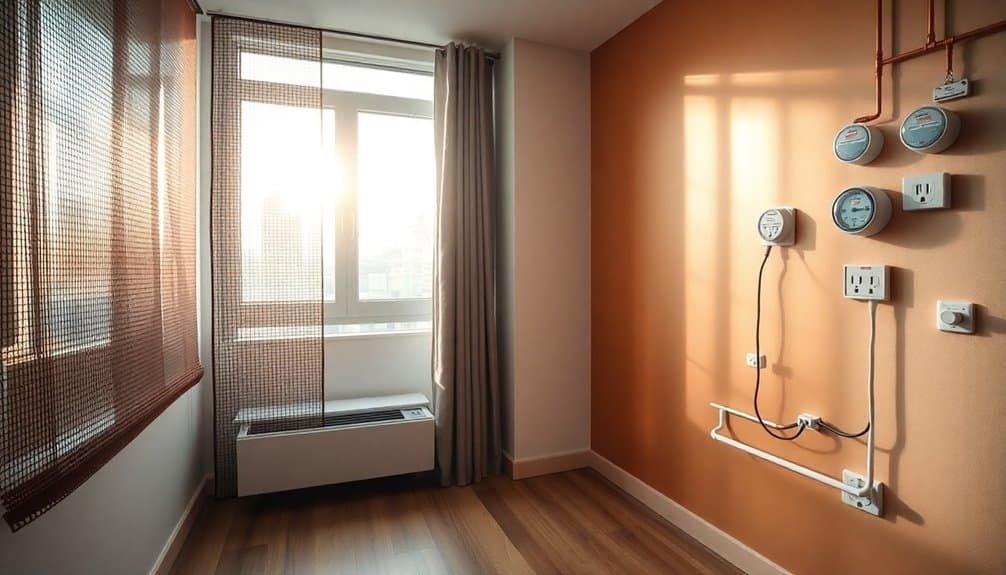How to Reduce EMF in an Apartment Building

First, identify EMF sources like wiring, appliances, and power lines, and use metallic shielding materials such as copper or aluminum to block them. Designate low-EMF zones by placing beds away from shared walls and outlets.
Enhance safety by retrofitting structures with shielded wiring and conducting regular EMF surveys. Implementing these strategies will improve protection against electromagnetic radiation.
Disclaimer: As an affiliate, I may collect a share of sales from the links on this page.
Understanding EMF Sources in Apartment Buildings

Electromagnetic fields (EMFs) in apartment buildings primarily originate from various electrical sources. Power lines and transformers nearby can greatly increase your EMF exposure. Additionally, inadequate electrical wiring within the building often leads to higher EMF levels. Common appliances, such as shavers and hair dryers, emit low-frequency EMFs as well. Electric floor heating systems further contribute to magnetic field exposure. Furthermore, metal water pipes can carry EMFs due to current leakage. Understanding these sources helps you identify high-exposure areas, allowing for better monitoring and management of EMF levels in your living space. High frequency electromagnetic fields can also be caused by devices like Wi-Fi routers and mobile phones, emphasizing the need for increased awareness in urban living environments. Moreover, heated seats in vehicles emit EMF radiation that can add to overall exposure during commutes, making it important to consider all aspects of EMF sources in your daily life. Stay informed about potential risks to make safer choices.
Effective Shielding Techniques
Effective shielding techniques include using metallic materials like copper and aluminum, which block EMFs by reflecting or absorbing waves. You can apply conductive shielding paints to walls or use conductive meshes and foils for RF shielding. For enhanced protection, consider layered shielding applications, integrating these materials during construction or retrofitting older buildings. Employing the Faraday cage principle can effectively concentrate charges and improve safety. Additionally, incorporating architectural shielding strategies when planning new constructions can significantly reduce radiation exposure. Regular inspections are essential to verify shielding effectiveness, ensuring reliable protection against harmful EMF exposure in your apartment building. Using EMF shielding fabric for furniture covers can also help minimize exposure in high-use areas.
Architectural Design Considerations

When designing an apartment building, it’s essential to contemplate various architectural elements that can effectively mitigate EMF exposure. Select natural building materials to reduce radio frequency reflections. Optimize floor plans for low-EMF zones, especially in bedrooms and workspaces. Minimize reflective surfaces that can amplify exposure. Additionally, consider that electric current generates electric and magnetic fields as this could impact your design choices. Incorporating proper wiring practices into the design can further enhance the overall safety against EMF radiation.
Incorporate acoustic insulation materials to reduce noise and EMF simultaneously. Conduct EMF surveys to assess site safety, prioritizing locations with lower background levels. Evaluate proximity to external EMF sources, like cell towers. Implement effective wiring systems with shielded cables and rigorous grounding to minimize emissions, ensuring a safer living environment.
Utilizing Distance for EMF Reduction
To effectively reduce EMF exposure in your apartment, it’s crucial to leverage the principle of distance. Increasing your separation from electrical appliances and wiring greatly lowers EMF levels.
For instance, position your bed away from shared walls with neighboring units to minimize exposure. Arrange furniture to keep it distant from electrical outlets. Additionally, select apartments away from power lines for better protection.
If you’re designing or renovating living spaces, aim to maximize the distance from electrical sources. Remember, even the height of your building can play a role in reducing exposure, especially if you choose higher floors.
Retrofitting Existing Apartments

Retrofitting existing apartments offers a practical approach to reducing electromagnetic field (EMF) exposure. Start by conducting EMF surveys using multimeters to measure current levels.
Identify sources like electrical wiring and Wi-Fi routers. Map hotspots to prioritize retrofitting efforts based on severity. Gather tenant feedback regarding discomfort or sleep disturbances to inform your decisions.
Developing a budget plan guarantees funds are allocated effectively. Consider replacing existing wiring with shielded metal-clad (MC) options and position electrical components away from living spaces.
Regular EMF testing over time will help monitor changes and validate the effectiveness of your retrofitting efforts, guaranteeing long-term benefits.
Choosing the Right Materials
Selecting the appropriate materials for EMF shielding is crucial for effective reduction of exposure within apartment buildings.
Use metallic materials, like aluminum and copper, for their high conductivity, which absorbs or scatters EMF photons. Incorporate eco-friendly EMF shielding fabrics for curtains and clothing.
Reflective insulation, such as Reflectix, can block up to 96% of radiation. Implement shielded metal-clad wiring to contain EMF within walls.
Design with the Faraday cage principle in mind, concentrating electrical charges externally. Regular maintenance of these materials guarantees ongoing effectiveness, while strategic positioning of electrical components can further minimize magnetic field emissions in living areas.
Promoting Awareness and Safety Measures
While many residents may be unaware of the potential dangers posed by electromagnetic fields (EMFs), understanding these risks plays an essential role in promoting safety.
Common sources, like WiFi routers and smart meters, can increase exposure. Research suggests a possible link between EMFs and cancer, although findings remain inconclusive.
To minimize exposure, building designs can incorporate metal shielding techniques. Educating residents on EMF risks and encouraging discussions fosters a collective responsibility.
Conducting workshops and providing feedback channels can enhance awareness. By addressing these factors, you can help create a safer living environment within your apartment building.
Frequently Asked Questions
Can Plants Help Reduce EMF Levels in Apartments?
While some plants like snake plants and ivy might absorb certain harmful substances, their ability to reduce EMF levels isn’t scientifically proven. Placing them near devices may help indirectly, but effective EMF reduction methods exist.
What Appliances Emit the Highest EMF in Apartments?
Think of your apartment as a garden, where certain appliances are weeds. Microwaves, older air conditioners, circuit breakers, and cordless phones emit the highest EMFs, potentially overshadowing the serenity you’re trying to cultivate in your space.
Are There Emf-Safe Paint Options Available?
Yes, there are EMF-safe paint options available. These paints effectively shield against electromagnetic radiation, are eco-friendly, and easy to apply. You’ll find various brands offering products to enhance your safety indoors while maintaining aesthetics.
How Can I Measure EMF Levels in My Apartment?
Did you know that over 80% of households have EMF levels above recommended safety limits? To measure EMF levels in your apartment, use a high-frequency radiation meter, ensuring it covers the necessary frequency range for accurate readings.
Do EMF Shielding Products Require Maintenance Over Time?
Yes, EMF shielding products require regular maintenance over time. Inspect them for wear, clean with mild detergents, and replace damaged materials promptly to guarantee they remain effective in protecting against electromagnetic fields.
Conclusion
Reducing EMF in an apartment building is achievable through various techniques. Effective shielding, improved architectural designs, and materials that mitigate exposure are key. Maintaining distance from EMF sources is crucial, and retrofitting existing units can enhance safety. By implementing these strategies, you’ll minimize EMF exposure and promote well-being, significantly impacting shared living spaces.


